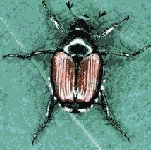Japanese Beetle
The Japanese Beetle

The Japanese beetle is one of the first pests people ask about during the summer months. They seem to be everywhere, on grapes, crepe myrtles, blackberries, apple trees and, oh yes, your roses! It’s that beetle with the shiny copper color and a shiny green top of the thorax and head. It is not very destructive in Japan where it is controlled by natural enemies. In America, it is a serious pest. It is a weak and clumsy flier and drops when it hits something. Japanese beetles have spiny back legs which they lift up in the air when approached. This is believed to be a defense to ward off predators.
|
| The beetles eat the surface of the leaves, leaving skeletal remains. It will devour rose blooms leaving nothing but a mess behind. With heavy infestations, they will appear to be piled on top of each other searching for something to eat.
|
| Japanese beetles are native to Japan. They were first found in the United States in 1916 in a nursery near Riverton, New Jersey. The theory is the beetle larvae entered the United States in a shipment of iris bulbs prior to 1912 when inspection of commodities entering this country began. They have migrated to now cover most of the eastern United States and parts of Canada. Japanese beetles are not yet found west of the Mississippi, although one appeared in Oregon and quickly eradicated. The beetle cannot survive in hot, dry climates.
|
| In the United States, the life cycle of Japanese beetle is one year; in Japan it is two years. The beetles emerge from the ground in late spring or early summer. They return to the ground to lay their eggs. The eggs hatch as larva or grubs and feed on the roots of grass. This stage is very susceptible to a fatal disease called milky spore. The larvae remain in the ground over winter and in the late spring the cycle starts over again.
|
| The USDA developed a biological control called Milky Spore® (Bacillus popilliae) that is commercially available in powder and granular form. The powder form is easily applied and lasts 15 to 20 years. The granular form requires three applications with a lawn spreader. It takes three years for the application to reach full potential although results may be seen within a few weeks. Larvae are also susceptible to certain members of the nematode families Steinernematodea and Heterorhabditodea that are also commercially available.
|
| The beetles in Japan have natural predators, but trying to get these predators established in the United States has met with limited success. Some birds (the meadowlark and cardinal) and some small mammals are predators of the adult beetles. |
| Natural repellents include catnip, chives, garlic and dead beetles. Beetle traps have been widely used but are falling out of favor. The traps work by attracting the beetles. The problem is, they attract more than they catch and you need to put them a good distance from what you want to protect.
|
| Some members of Shenandoah Rose Society have been experimenting with Bounce® dryer sheets, attaching them to the rose plants. This works in repelling the beetles, but the sheets need to be replaced after a rain. Other brands have been tried but they do not work.
|

